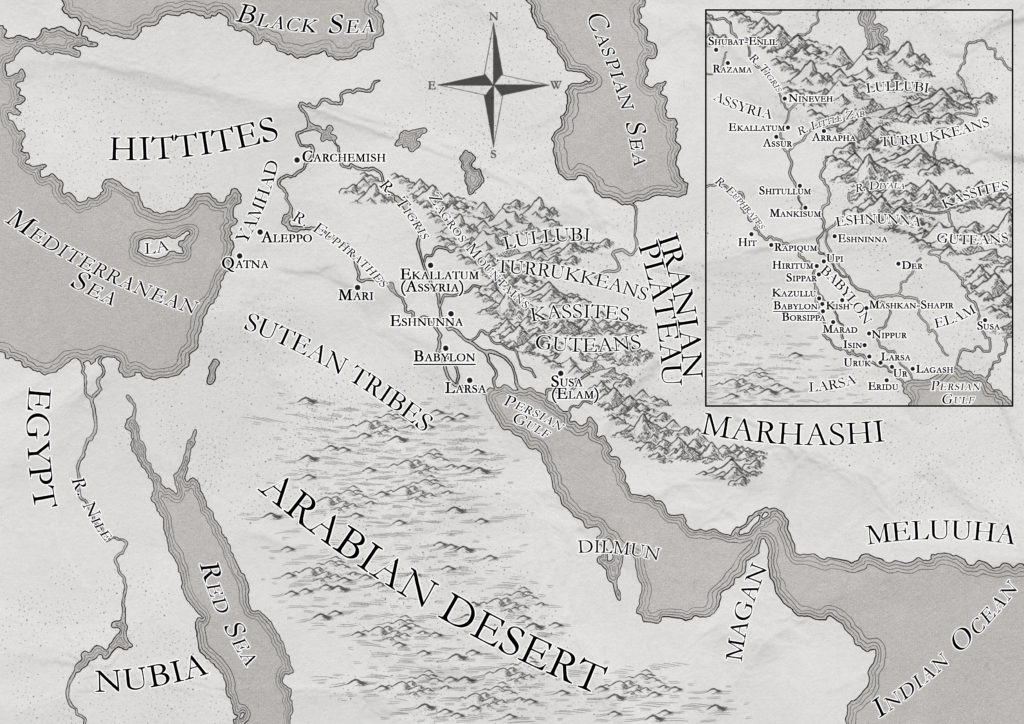
Born: Babylon, 1832 BCE
Position: Personal Secretary to Hammurabi, later Ensei of Larsa
Family: Father of Queen Anatu, grandfather of Samsuiluna, brother of Sinbelaplim, uncle of Ibbi-addu and Ikupi-addu.
Rise to prominence
The son of a powerful noble, Sin Iddinum was sent to the tablet house as a young boy, learning the skills of a scribe. His father instilled a belief that their family were destined to rule Babylon. Sin Iddinum burned with desire to see that vision come true. When he turned 19, his father secured him a position in the palace. He soon came to the attention of King Sin-Muballit.
In 1808 BCE, at the age of 24, Sin Iddinum became one of prince Hammurabi’s tutors. That same year, his brother Sinbelaplim came to court and began working for the king’s spymaster.
In 1800 BCE, at the age of 32, Sin Iddinum married a young noblewoman called Tashmetum. A year later, their eldest daughter was born. Two stillborn sons would follow soon after.
In 1796 BCE, King Sin Muballit came back form an ill-advised campaign against Larsa with a severe head injury. Young prince Hammurabi had to take control of the kingdom, and Sin Iddinum became his personal secretary and most trusted advisor. By the following year, Sin Muballit was dead.
Family heartbreak
By 1791 BCE, Sin Iddinum had given up on ever having a son. However, Tashmetum never gave up hope. She constantly prayed to the different fertility gods. One day, after giving an offering and a prayer to an obscure northern goddess of fertility, Tashmetum felt a quickening in her womb.
The pregnancy was difficult, and the birth even more so. Tashmetum never truly recovered. She died soon after naming her miracle child Anatu, after the goddess. Sin Iddinum was thrown into a deep depression after the birth, despairing of losing his wife and of ever making his father’s dream a reality.
Creating a legacy
1776 BCE a great plague swept Babylon. Both Hammurabi’s wives died, along with his eldest daughter. The gods had left Sin Iddinum with an opportunity he could not pass over. Quickly bringing his daughter Anatu to the palace, the pretty young girl managed to catch the king’s eye. With suitable encouragement from his old mentor, Hammurabi married Anatu in 1775 BCE, and she swiftly fell pregnant.

Sin Iddinum put plans in place to keep Anatu as Hammurabi’s only queen, aided by the turmoil in the region.
Mari’s new ruler Zimri-lim had begun a series of revenge killings of Bene Yamina tribesmen in the north. These tribes were under the protection of Hammurabi, and he would have to respond. Meanwhile, Larsa and Eshnunna sought opportunities to take Babylonian territory, as well as threaten the interests of the Empire of Elam.
Sin Iddinum sensed opportunity once more. Using his brother Sinbelaplim’s spy network, he reached out to an Elamite noble with a peace proposal. With Elam offering to broker peace between Babylon and Mari, as well as take care of Eshnunna and Larsa, Hammurabi was forced to accept a lesser bride. This bride would be Ellat, the mother of Bani.
With careful prompting from Sin Iddinum, Hammurabi was guided not to make Ellat his second queen. Her family connections meant he could not slight the Elamites by making another woman queen after her, securing Anatu’s position and that of her unborn child.
In 1774 BCE, Sin Iddinum’s first grandson, Samsuiluna, was born. His elder daughter had proved unable to bear a living child, while his brother had only two daughters. Finally, Sin Iddinum had a boy he could build a legacy around. The only problem was, Hammurabi had two older sons, Mutu-numaha and Sumu-ditana. He would need to get rid of them, if Samsuiluna was to sit on the throne of Babylon…
Leave a Reply